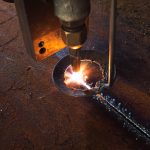Welding inspection is an essential process in various industries, ensuring that structures and components are safe and of high quality. With technological advancements, automation has begun to play a fundamental role in this field, transforming the way inspections are conducted. This article will explore the benefits of automation in welding inspection, highlighting its impact on efficiency, precision, and safety.
1. Increased Efficiency
One of the most significant benefits of automation in welding inspection is the increased efficiency of the process. Automation allows for faster inspections, reducing the time required to complete each task. For example, automated systems can scan and analyze welds in a fraction of the time it would take a human inspector.
This not only speeds up the production process but also enables companies to increase their production capacity without compromising quality. The implementation of automated technology means that inspectors can focus on more complex and critical tasks, thereby improving overall productivity.
2. Improved Precision and Consistency
Automation also contributes to greater precision in welding inspection. Automated systems use advanced technologies, such as high-resolution imaging and data analysis, to identify defects that may go unnoticed by a human inspector. This ability to detect failures accurately and consistently improves the overall quality of the work performed.
Moreover, automated systems are less prone to human error, which can arise from fatigue or distraction. Consistency in inspection is crucial for meeting quality standards and industry regulations, and automation helps ensure that each inspection is conducted uniformly and reliably.
3. Cost Reduction
In the long run, automation can result in significant cost reductions for companies. Although the initial investment in automated technology may be high, the savings achieved in inspection time and the improvement in product quality can offset those costs. By reducing the need for labor for repetitive tasks and decreasing the failure rate of products, companies can save on operational and rework expenses.
Additionally, automation can minimize the risk of accidents and costly errors, which also contributes to cost reduction. In welding inspection, where defects can lead to expensive repairs or even structural failures, this savings is crucial.

4. Enhanced Safety
Safety is a primary concern in the welding industry. Automation helps improve workplace safety by reducing inspectors’ exposure to hazardous environments. Automated systems can carry out inspections in hard-to-reach areas or dangerous conditions, thereby minimizing the risk of injury.
Furthermore, by improving the quality of welds through more accurate inspections, automation contributes to the overall safety of structures and final products. Fewer welding failures mean a lower risk of accidents and greater confidence in the integrity of constructions.
5. Data Analysis and Traceability
Automated inspection systems often incorporate data collection and analysis capabilities, allowing companies to gain valuable insights into their welding processes. This information can be used to identify trends, assess performance, and make continuous improvements in quality.
Traceability is another important aspect. With automation, each inspection is documented and can be easily tracked. This is not only useful for complying with industry regulations and standards but also facilitates the identification of recurring issues and allows companies to address the root causes of defects more effectively.
6. Flexibility and Adaptability
Automation in welding inspection also offers greater flexibility and adaptability. Automated systems can be programmed to perform different types of inspections as needed, allowing companies to quickly adjust to changing market demands. This is particularly useful in industries where projects can vary in size and complexity.
Moreover, the ability to update and improve the software and technology used in automated systems ensures that companies can keep up with advancements in inspection technology without needing to replace all equipment.
7. Improvement in Employee Morale
Automation not only benefits companies but can also improve employee morale. By reducing the workload of repetitive and hazardous tasks, inspectors can focus on more challenging and rewarding activities. This can not only increase job satisfaction but also foster a more positive work environment.
Motivated and engaged staff are essential for the success of any company, and automation can play a key role in creating a work environment where employees feel valued and supported.






